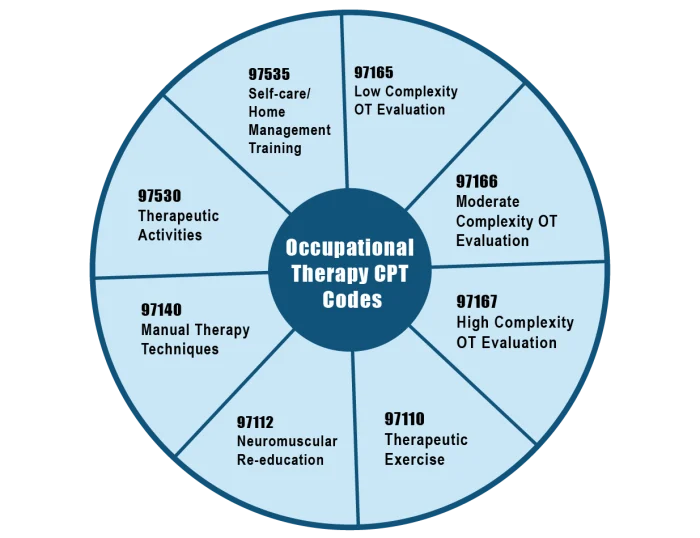
Top CPT Codes for Occupational Therapy Billing in 2025
Why Accurate CPT Coding Matters for OT Practices in 2025
- Higher audit risks when coding errors or insufficient documentation are found.
- Stricter rules for timed vs. untimed codes, particularly for Medicare.
- Lost revenue opportunities due to denied or underpaid claims.
OT services are often individualized and complex, making it crucial to document and code each session accurately. The right CPT code communicates the service provided, its complexity, and its medical necessity. Missteps here can result in compliance issues and financial penalties.

Top Occupational Therapy CPT Codes for 2025
To help you stay current, here are the most frequently used OT CPT codes for 2025, along with what they represent:

97165 – Low Complexity OT Evaluation
97166 – Moderate Complexity OT Evaluation
97167 – High Complexity OT Evaluation
97110 – Therapeutic Exercise
97112 – Neuromuscular Re-education
97140 – Manual Therapy Techniques
97530 – Therapeutic Activities
97535 – Self-care/Home Management Training
Additional codes often used in OT include those for modalities such as electrical stimulation, ultrasound, or group therapy sessions. Many of these codes are timed, meaning reimbursement is based on the duration of service, while others (like evaluations) are untimed. Understanding the difference is key to avoiding underbilling or overbilling.
OT Billing Best Practices for 2025
Understand the Medicare therapy threshold
Document medical necessity thoroughly
Apply the 8-minute rule correctly
Avoid duplicate or missing codes
Stay updated on payer requirements

READ MORE: Outsource Medical Billing in 2025
How MaxRemind Simplifies OT Billing and Improves Revenue
Managing billing in-house can be time-consuming and stressful. That’s why many OT practices are turning to specialized medical billing partners like MaxRemind. By outsourcing billing, providers can focus on patient care while ensuring their claims are accurate and compliant.
MaxRemind offers:
- Expert CPT and ICD-10 coding support tailored for OT services.
- Real-time claim submission and follow-ups to minimize delays.
- Denial management and revenue recovery for underpaid or rejected claims.
- Automated RCM tools and detailed financial reporting, giving you better insight into your practice’s revenue cycle.

Conclusion
If you want to simplify OT billing and improve your revenue cycle, consider partnering with a team that specializes in OT billing, like MaxRemind. Let professionals handle the coding and claims so you can focus on providing patient care.
Ready To Improve Your OT billing Practice Revenue Cycle?
- What are the most commonly used CPT codes for occupational therapy in 2025?
-
The most frequently used OT CPT codes include 97165–97167 for evaluations of varying complexity, 97110 for therapeutic exercises, 97112 for neuromuscular re-education, 97140 for manual therapy, 97530 for therapeutic activities, and 97535 for self-care training. Using these correctly with proper documentation helps ensure accurate billing and timely reimbursements.
- What is the difference between timed and untimed OT CPT codes?
-
Timed codes, like 97110 and 97140, are billed in 15-minute increments based on the actual one-on-one therapy time spent with the patient. Untimed codes, such as the evaluation codes 97165–97167, are billed once per session regardless of the duration, but documentation must still reflect the services provided.
- How can OT practices avoid claim denials related to CPT coding?
-
To reduce denials, ensure documentation supports medical necessity, follow payer-specific billing rules, and use modifiers like KX or 59 correctly when required. Regular audits, proper code selection, and staff training on insurance policies also help prevent billing errors and delays.
- What are the Medicare OT therapy thresholds for 2025?
-
Medicare maintains an annual therapy threshold for occupational therapy services, and once a practice exceeds this amount, the KX modifier must be added to justify continued medical necessity. Practices should monitor patient progress and maintain detailed records to stay compliant and avoid reimbursement issues.
- How can outsourcing OT billing to a company like MaxRemind help my practice?
-
Outsourcing OT billing can save administrative time, reduce claim errors, and improve cash flow by leveraging expert coders who specialize in therapy billing. Services often include denial management, compliance monitoring, and payer follow-ups, which allow practices to focus more on patient care and less on billing complexities.
